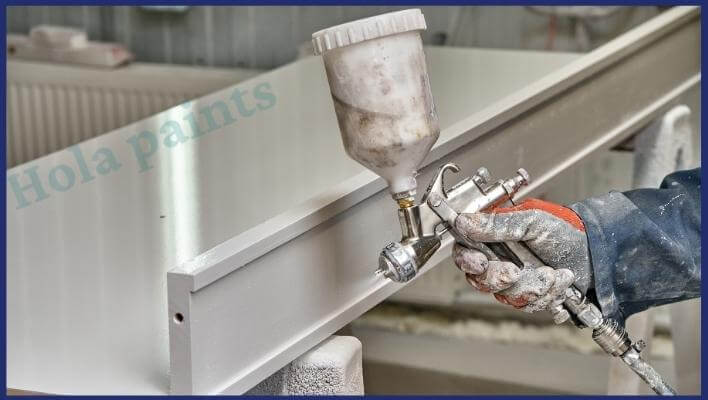If you love woodworking, having the right tools is important for a professional finish. When it comes to applying lacquer, the choice of sprayer can make a big difference.
In this guide, we’ll look at some of the best lacquer sprayers available. We’ll consider factors like performance, durability, and ease of use. Whether you’re a pro or a beginner, by the end, you’ll know which sprayers are worth considering. Let’s explore the world of lacquer sprayers together.
Table of Contents
- What is the best sprayer for lacquer?
- Best Paint Sprayers for Lacquer Reviews 2023
- 1. Fuji Spray 9600-G Gravity G-XPC-Best Professional Lacquer Sprayer
- 2. Graco 257025 Project Painter Plus Paint Sprayer-Best Airless Lacquer Sprayer
- 3. Ingersoll Rand 210G Gravity Feed Spray Gun-Best Lacquer Sprayer For Cabinets
- 4. Astro Tool EVOT14 Spray Gun with Plastic Cup-Best Spray Lacquer For Wood
- 5. Ingersoll Rand 270G HVLP Gravity Feed Spray Gun-Best Cheap Spray Gun For Lacquer
- 6. Wagner 0518080 Paint or Stain Sprayer-Best Lacquer For HVLP Sprayer
- How do Lacquer Spray Guns work?
- How to spray lacquer with HVLP?
- Lacquer Spray Gun Types
- What type of sprayer is best for lacquer?
- How should you apply lacquer?
- Use Paint Sprayer To Apply Lacquer
- Application of lacquers with HVLP vs. LVLP
- Ideal Features of the Lacquer Spray Gun
- Considerations Before Buying a Spray Gun for Lacquer
- Power Output
- Fluid Capacity
- Clean-up
- Nozzle / Tip sizes
- Varnish vs. Lacquer
- Conclusion On Best Lacquer Sprayer
- FAQS On Best Sprayer for Lacquer
What is the best sprayer for lacquer?
| IMAGE | PRODUCT | DETAILS | PRICE |
|---|---|---|---|
|
BEST PROFESSIONAL
|
Fuji Spray 9600-G Gravity G-XPC |
|
Check on Amazon |
|
BEST BUDGET
|
Ingersoll Rand 270G HVLP Gravity Feed Spray Gun |
|
Check on Amazon |
|
BEST VERSATILE
|
Graco 257025 Project Painter Plus Paint Sprayer |
|
Check on Amazon |
|
BEST LACQUER FOR CABINETS
|
Astro Tool EVOT14 Spray Gun |
|
Check on Amazon |
|
BEST LACQUER FOR SPRAYING
|
Ingersoll Rand 210G Gravity Feed Spray Gun |
|
Check on Amazon |
|
BEST HVLP FOR LACQUER
|
Wagner 0518080 Paint or Stain HVLP Sprayer |
|
Check on Amazon |
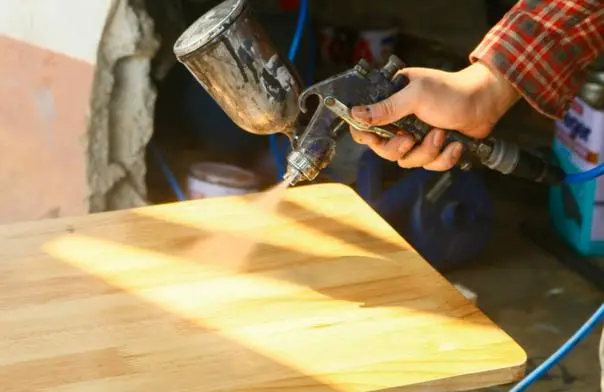
Best Paint Sprayers for Lacquer Reviews 2023
1. Fuji Spray 9600-G Gravity G-XPC-Best Professional Lacquer Sprayer
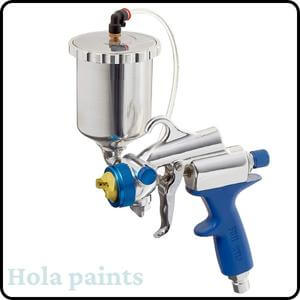
A Fuji spray gun has not been designed with a budget in mind, but you will have a premium sprayer that looks great and functions well.
In my opinion, this device is amazing to use because of the gravity-fed canister. The gravity cup and tilt feature allow this model to spray in any direction, even upwards. There is an adjustable angle on the gravity cup 400cc.
Although this is a beautiful unit, it could be larger in terms of capacity. The cup has a capacity of 400cc (400ml). When you spray a large piece, you will almost have to refill the canister frequently.
In addition, you will experience less wrist and hand fatigue mainly due to the stainless steel and the insulated handles.
This non-bleed gravity spray gun features an exclusive side knob to adjust fan size, as well as a high-efficiency 1.4mm air cap that can be used with lacquers, enamels, polyurethanes, latex, and water-based coatings.
G-XPC Gravity Spray Gun is a non-bleed gun, which means less blowing of dust in the spray area, fewer paint buildups at the nozzle tip, and has a reduced noise level.
Would you like more information about polyurethane vs lacquer?
- An adjustment knob allows for small to large fan patterns
- Less paint builds up on the fluid nozzle tip
- 400cc side-mounted paint cup
- Ergonomically designed sprayer with cool handle
- Strong construction (metal body)
- Only weighs 2.7 lbs
- The insulated handle reduces vibration
- Pressure and gravity feed combination
- 2-years warranty
- The control switch is sensitive
- Expensive
- A canister holds 400 cc’s of fluid
Moreover, bathroom refinishers prefer to use the G-XPC, but it can be best used for automotive, cabinets, and furniture as well. Hence, every time you use this product, you’ll notice its quality.
Useful Resource: Detailed information about lacquer thinner and paint thinner can be found here.
2. Graco 257025 Project Painter Plus Paint Sprayer-Best Airless Lacquer Sprayer

Five gallons of lacquer at one time, making it suitable for multiple projects without the need to refill it.
However, this machine uses pressure to draw lacquer through it, so it requires proper cleaning. So, when you are using this lacquer paint sprray gun you must clean it properly and then apply a thick layer of sticky lacquer.
The sprayer can spray 50 gallons annually. Also, the airless paint sprayer offers adjustable settings, so you can adjust the pressure and flow of paint.
There is a motor that can deliver 2800 PSI. Considering the sprayer’s speed, it is able to spray at least 0.24 gallons per minute.
Many tips can be used with it, including 0.009, 0.011, 0.013, and 0.015. Lacquer is best applied with the 0.013 tips.
Also, with the hose adaptor, you can quickly clean sprayers by connecting a garden hose.
Useful Resource: See our detailed review of the Graco Magnum Painter Plus for more details.
- Simple to clean
- Suitable for small to medium projects
- A powerful motor capable of 2800 PSI
- Adjustable speed and flow of material
- Not for professional use
- Large capacity may lead to overspray
Our testing of the Graco Magnum Project Painter Plus Paint Sprayer revealed that it is a compact, time-saving tool that performs well at a relatively low cost. However, if you tend to paint larger projects, then you can consider its big brother Graco X5 model.
3. Ingersoll Rand 210G Gravity Feed Spray Gun-Best Lacquer Sprayer For Cabinets

An Ingersoll Rand spray gun is a cost-effective alternative that offers high-pressure lacquer at no extra charge.
With this sprayer, you will get a great quality finish, easy to use, and is affordable, even beginners have a chance to learn about its adjustable settings and finish jobs without the hassle of high prices.
The Ingersoll Rand Edge Series features adjustable knobs that give you a great deal of control.
It is suitable for applying paint, stains, lacquers, and other finishes. Plus, there is a non-drip cup to prevent paint from splashing and messing up.
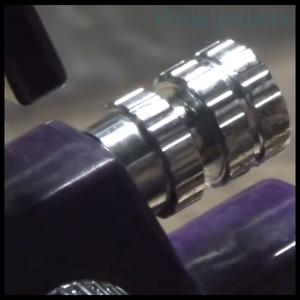
You can adjust the airflow with this sprayer by means of an air adjustment valve. This allows users to get just the right mix for their renovation needs. Additionally, this paint gun is compatible with multiple paint types.
By controlling the airflow, you will avoid any excess lacquer that you may not need when using the machine.
It can withstand a working pressure of 60 PSI and spray evenly. Besides the plastic cup and 0.63-quart capacity, the spray gun also has a one-year warranty to ensure its efficiency.
However, some owners even claim that it outperforms more expensive options in terms of ease of cleaning. You can aslo buy it from Home depot.
- It can handle high pressure
- User-friendly sprayer
- The cup doesn’t drip
- Air valve for easy adjustment
- A suspension hook is included
- Easy to break
- Not suitable for all lacquers
An Ingersoll Rand product provides the benefits of high-pressure lacquer spray gun but at a lower cost. If you would like to restore furniture, paint a fence or your entire house, then Ingersoll Rand would be your best option.
4. Astro Tool EVOT14 Spray Gun with Plastic Cup-Best Spray Lacquer For Wood
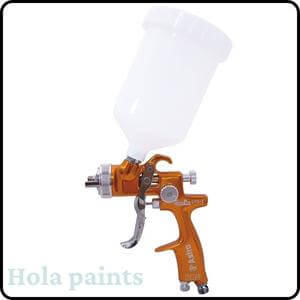
The Astro Tools EVO-T gun is an excellent lacquer spray gun for people who expect to work in larger areas. A gravity-feed LVLP type, the Astro Tools spray gun has a 1.4 mm tip and it supports a working pressure of 15-19 PSI.
I have noticed that its pattern width is also adjustable, from 9.25 inches to 10.25 inches. It also comes with a plastic cup with a capacity of 600 ml or 0.6 quarts.
The anodized body makes it corrosion-resistant. Additionally, a soft trigger pull might also seem appealing as it lessens fatigue while operating, making it extremely user-friendly.
Some verified purchased user didn’t like the inconsistent spraying of the spray gun. However, this paint sprayer will help you complete your auto body repairs in a timely manner. Both professionals and weekend mechanics will be able to use it to get a show-quality paint finish again on their vehicles.
This product is manufactured from top-notch materials and one year warranty ensures that this lacquer spray gun will last for a long time.
- Large pattern area
- Anticorrosion product
- Smooth trigger pull
- It includes stainless steel needles
- Cleaning easier and faster
- Lightweight
- Air Curtain design to control overspray and reduce pollution
- Improved transfer efficiency reduces paint consumption
- Quality atomization
- Advanced EVO-T technology
- Best spray gun lacquer
- The spray may not be consistent
You can use lacquer paint for antique or classic cars where high gloss and shine are desired. Also, you can fix car paint damage and save money by using this user-friendly paint repair product.
Useful Resource: If you’re interested in painting over lacquer, check out this guide!
5. Ingersoll Rand 270G HVLP Gravity Feed Spray Gun-Best Cheap Spray Gun For Lacquer

Ingersoll Gravity Feed Spray Gun is an excellent HVLP painting model. The Lacquer spray guns come in a variety of sizes, but this one has a 1.5mm tip size and a 1qt capacity.
The machine is well suited to the application of paint, lacquer, stain, and other finish materials. The low-pressure, high-volume spray gun is designed to reduce overspray and help improve painting results.
The air adjustment valve and air regulator are two features that customers like about the Ingersoll Rand 270G Gravity Feed Spray Gun.
The adjustable pattern width and the maximum working pressure of 40 PSI ensure that users will get the desired results every time.
A one-year warranty comes with the Ingersoll Rand 270G HVLP Gravity Feed Spray Gun, so you can rest assured that you will be able to rely on it for many years to come.
- 1-quart container
- Adjustable air pressure regulator
- Portable
- HVLP gravity-feed spray gun
- Suspension hook
- An affordable cost
- Get clogged up with thick paint on the tip
With the 270G gravity-feed spray gun, you will enjoy exceptionally rugged, compact, and lightweight performance.
Ingersoll Rand 270G HVLP Gravity Feed Spray Gun and Ingersoll Rand 210G Gravity Feed Spray Gun are two popular spray guns. Below are quick comparisons of the both models.
| Ingersoll Rand 210G Spray Gun | Ingersoll Rand 270G Spray Gun | |
| Style | Gravity Feed Spray Gun | HVLP Gravity Feed Spray Gun |
| Powered Source | Air Powered | Air Powered |
| Weight | 2.6 | 2.7 |
| Cup capacity | 20 | 33 |
| Air consumption | 11 | 8 |
| Material | Plastic | Metal/Plastic |
6. Wagner 0518080 Paint or Stain Sprayer-Best Lacquer For HVLP Sprayer
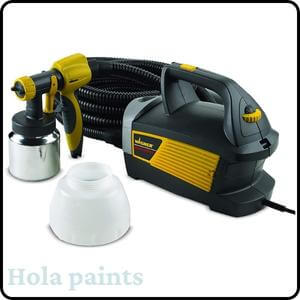
When you need to paint a surface quickly, you will need a sprayer, which can be extremely reliable in this regard. A paint sprayer like this one won’t break the bank.
Wagner Spraytech Control Spray Max Sprayer has an adjustable pattern width, from 5 to 12 inches. The sprayer has a 1.5 mm tip.
Despite the smaller scale, the product is unable to handle large areas as it has a low capacity.
The package includes two cups. The first cup is made of plastic and holds 1.5 quarts of lacquer, and the second cup is made of metal and holds one quart of lacquer.
In addition to the 20-foot hose, the Wagner Spraytech Control Sprayer features a pressure control dial and an adjustable material flow setting. It is perfect for small DIY projects.
As a paint professional, I would suggest you to follow the manufacturer’s instructions for mixing lacquer, as different types of lacquer may require different amounts of thinner to achieve the right consistency for spraying.
In general, it is good to add 1 or 2 ounces of thinner per quart of lacquer with this sprayer as per my experience. However, it’s important to remember that this can vary depending on the specific brand and type of lacquer. In addition, it can vary depending on the environmental conditions under which you spray.
If the lacquer container recommends a particular type of thinner, it’s best to use that specific thinner to ensure optimal results. However, if no specific thinner is recommended, you can use a generic lacquer thinner. When thinning lacquer, it’s important to mix it thoroughly and test your spray technique and settings on a small, inconspicuous area before beginning your project.
Helpful Resource: For more information on the Wagner 0518080, please refer to our detailed review here.
- Compact and light sprayer
- Best Wagner sprayer for lacquer
- Easy to adjust
- With no compressor required
- Adjustable flow and air pressure
- Needs frequent cleaning
- Not suitable for large areas
A product that goes beyond that level of usefulness is hard to find. As these products are usually bulky and heavy, a small lacquer spray paint gun is a better choice regarding handling and weight. However, it is the most convenient option for complex tasks.
How do Lacquer Spray Guns work?
A lacquer spray gun functions like a normal spray paint gun due to its high velocity and low pressure. Lacquer requires high pressure due to its high adhesion and thickness. Lacquer is forced through the nozzle of the spray gun by the pressure feed. This pressure feed can draw lacquer from the tube and create a vacuum chamber. As a result, lacquer is able to flow from the gun into the tube.
During application, the lacquer is sprayed evenly over all the surfaces at a high velocity from the nozzle.
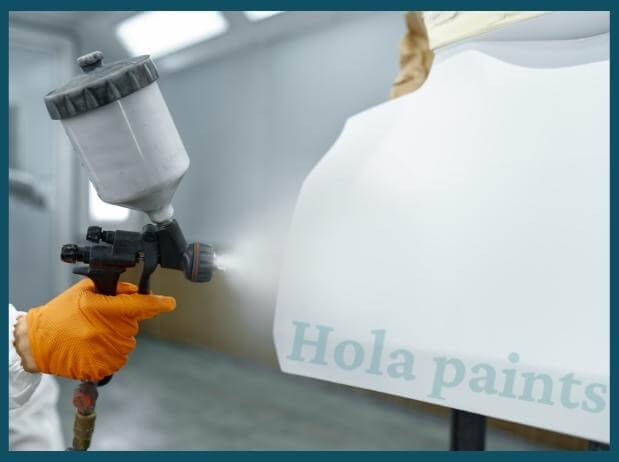
How to spray lacquer with HVLP?
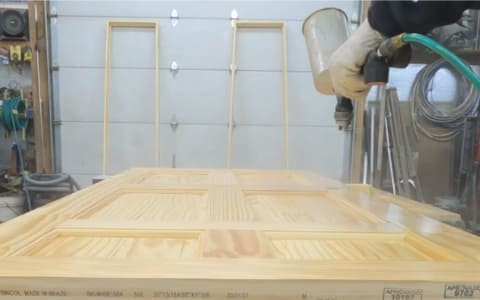
In my recent woodworking project, I delved into the world of spraying nitrocellulose lacquer on various surfaces, particularly focusing on cabinets and trim. The goal was to achieve a professional finish while maintaining simplicity and efficiency in the process.
One key tip is to stir the lacquer thoroughly before use, ensuring that any settling flattening agents are well-mixed. This step is often underestimated but holds significant importance to get uniform sheen.
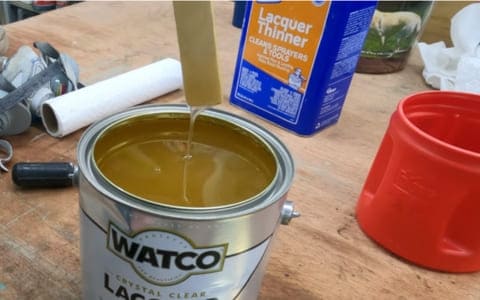
Next, I experimented with the lacquer-to-thinner ratio, as using an HVLP sprayer requires a balanced mixture for proper atomization. Starting with a 70% lacquer to 30% thinner ratio, I adjusted based on the spray results. The aim is to achieve a fine mist, akin to an aerosol can, ensuring even coverage on the surface.
In terms of equipment, I got a budget-friendly HVLP sprayer, highlighting that expensive tools aren’t a prerequisite for quality results. Adjusting the fan width and pressure settings on the sprayer allowed me to tailor the application to different surfaces, whether cabinets, trim, or doors.
An essential consideration is the orientation of the spray pattern. Initially, I sprayed along the length of surfaces, but as the project progressed, I switched to spraying across the width. This technique helped maintain a wet edge, minimizing dry spots and ensuring a smoother finish.
During the process, I understand the significance of sanding between coats using flexible sanding pads. This step is important for knocking down any raised grain and achieving a smoother final result. I showcased the flexibility of these pads, especially in reaching grooves and edges effectively.
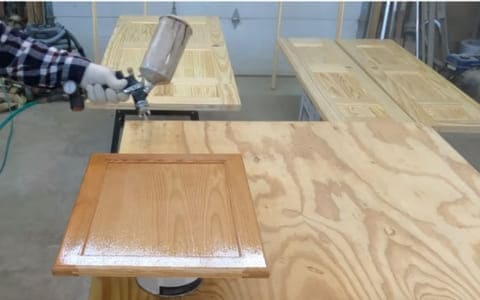
To provide a visual representation, I shared images of the project at various stages, including the application on cabinets, doors, and trim. The drying process was also discussed, emphasizing the quick-drying nature of nitrocellulose lacquer as a notable advantage.
Lacquer Spray Gun Types
- Spray guns that spray lacquer are similar to those that spray paint, so knowing the differences can help you choose the right one. You can find spray guns designed specifically for lacquer used.
- With high pressure, the lacquer is able to pass more easily through the gun. Due to its greater adhesive properties, lacquer requires more force than paint. By using the wider nozzle, you ensure that the coat is applied evenly to your surfaces. Also, your surfaces will not suffer from bubbles or patches.
- A spray gun that is designed for use with both paint and lacquer is also available. The components of the gun can easily be removed, so you have an easier time applying lacquer. Additionally, paints, stains, and lacquers are easy to swap with spray guns.
- Also, there are different types of sprayers, such as HVLP sprayers, LVLP sprayers, and airless sprayers, among others.
- HVLP spray guns deliver high volumes of air, enabling them to stain or paint the surface at high pressure. Due to the fact that they use an air compressor, they are widely recognized as the finest high-quality tools in the industry.
- Spray guns for LVLP systems are not very common and are considered to be beginner-friendly. Secondly, they are considered weak in comparison with HVLP sprayers. However, they are capable to simplify the process of spraying.
- The motor that compresses lacquer and paint in an airless spray gun is a bit different from a regular spray gun. The motor compresses paint instead of air. The result is that they do not produce bubbles and have a smooth finish. But they aren’t the preferred option for DIY projects.
What type of sprayer is best for lacquer?
Lacquer is very thin material, so too much pressure will result in tons of overspray and wasted lacquer. Therefore, you should consider purchasing a HVLP paint sprayer. These lacquer spray guns are also a suitable choice for DIY experts.
The key to spraying lacquer with HVLP is to be careful about the setup of the spray gun to ensure that it applies the lacquer consistently as desired. HVLP spray guns for lacquer are easier to clean and more versatile than other sprayers.
How should you apply lacquer?
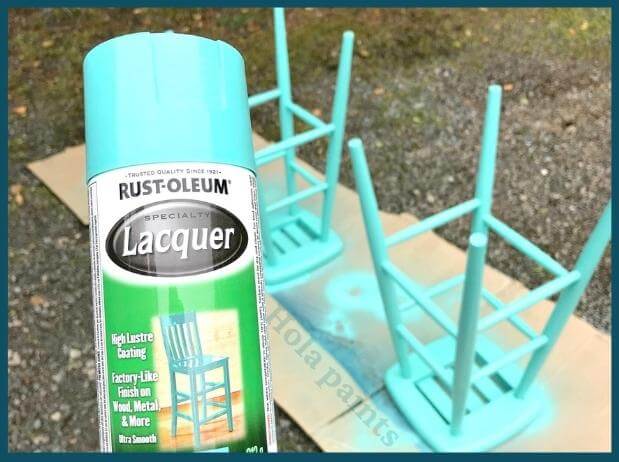
The use of a roller and brush can result in brushstrokes and over application, so we recommend using a spray paint cans or sprayer instead. Modern sprayers handle both standard paint and lacquer, which is a blessing.
Use Paint Sprayer To Apply Lacquer
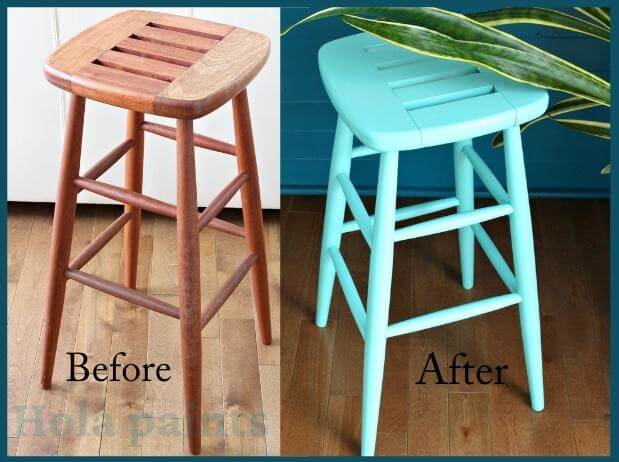
Our goal is to complete projects to the highest standards, which means we devote a great deal of time to select the right consistency and color while visualizing the finished product in our minds.
Lacquer can be the perfect finish for your piece, which gives it an elegant sheen.
These sprayers have a higher PSI output and large spray nozzles to use the thick, sticky formula of lacquer. Therefore, if you want the lacquer to be applied properly, you’ll need a spray gun that outputs high pressure.
Paint is thinner than lacquer, so a lower pressure is needed to ensure the correct viscosity for painting than the significant force required to propel lacquer through a spray gun’s tip.
It can then be atomized and sprayed directly onto the work piece, resulting in a clear protective coating.
The first coat should be allowed to set for a few hours before the second coat is applied. After the surface has dried, you can roughen it up with sandpaper. Next, apply the second layer. Now, repeat this process three more times for a long-lasting finish. With lacquer, your surfaces will be protected from scratches and from water damage.
Application of lacquers with HVLP vs. LVLP
Which is better for painting sprayers: an HVLP or an LVLP? There is no obvious winner, each is better suited for their respective applications, so choosing one depends entirely on your goals.
However, the HLVP sprayer is the most suitable option when working with lacquer because of its adjustable air pressure. This enables you to spray lacquer with enough force to expel it.
Moreover, professionals painting experts prefer HVLP spray gun when it comes to lacquer spraying.
Ideal Features of the Lacquer Spray Gun
- Low pressure.
- Small nozzles for thin material (A 1.3mm spray tip will work best for lacquers, but the tip size for a turbine machine should be 1.5 mm)
- More fluid capacity.
- Easy adjustment of pressure and material flow.
- Stainless Steel Parts.
Considerations Before Buying a Spray Gun for Lacquer
Lacquer need specific requirements for spray guns to perform effectively. Using a sprayer that does not meet the criteria will damage the entire unit. So, make sure your paint sprayer meets the following requirements.
Power Output
Due to the dense nature of lacquer, a pressure is needed to atomize it for spraying. A sprayer with a low power rating will have difficulty providing enough pressure. This can clog your sprayer, which is messy to clean up if you have never done so before.
When buying a sprayer, you need to consider the fact that very low power output may result in lacquer splattering on your work place. You can check the sprayer’s packaging or the manufacturer’s website to find out its power rating. Therefore, when purchasing your sprayer, it is wise to check its power rating.
You need a lacquer sprayer with a maximum pressure of 1100 PSI. As the PSI level increases, the sprayer is able to atomize the lacquer more easily.
Fluid Capacity
The problem is that when you have a spray gun with a small paint container, you need to constantly refill lacquer as you work. A smaller canister can slow your work process. Therefore, you should always consider the maximum volume your sprayer can handle, as well as the type of work you do regularly. This will help you to decide whether a canister provided in the box will be sufficient for your needs.
If the in-box paint container does not satisfy your needs then visit the manufacturer’s website to see if larger containers are available for your specific paint sprayer.
Clean-up
Cleaning is a chore no one enjoys. When you have spent hours priming, painting, and applying lacquer, the last thing you want to deal with is cleaning your sprayer.
A clean and well-maintained sprayer will last a long time. You must clean the paint canister and the gun when you are working with a lacquer or a varnish sprayer. If you leave varnish or lacquer in it, it can cause severe damage to the sprayer’s primary parts or clog your supply line and nozzle.
If necessary, take the affected components and soak them in a solvent or use a low-pressure cleaner and sprayer-safe solvent to effectively clean the sprayer.
Nozzle / Tip sizes
There is a great deal of importance in getting a tip that matches the material you will spray. A large nozzle is useful with thicker paints, such as primers. Lacquer and other thin materials do well with small nozzles.
Spray tips for lacquers are usually around 1.3mm, but if you plan to use an HVLP turbine system, make sure the tip size is 1.5mm because it will require less force to push paint.
Varnish vs. Lacquer
The two terms look similar to the casual observer, so they are often used interchangeably. However, there are a few points of differences you should know.
A varnish is a glossy, transparent, hard surface coating. Varnishes have three coatings: resin, drying oil, and solvent. Alternatively, lacquers contain solvents, dissolved nitrocellulose, plasticizers, and dyes.
Shellac adds shine to lacquers. Unlike varnishes, lacquers contain pigments that can color wood while varnishes rarely contain color.
Varnishes vary from semi-gloss to low-sheen.
Lacquer will last longer than varnish. Plasticizers are present in lacquers, which makes them hard and resistant to liquids, protecting surfaces from acidic damage. Therefore, lacquers are known for their durability.
Conclusion On Best Lacquer Sprayer
Your creativity will begin to flow once you find your best sprayer for lacquers.
Here it is! The three best choices! In our list, we have the Fuji Spray 9600-G Gravity G-XPC Spray Gun, which is to be our favorite. We love Fuji sprayer because it has an adjustable pattern control knob, comes with a 1-year warranty, and has a nylon-covered handle that provides a comfortable grip.
Next, we have the Wagner Paint Sprayer, which is our best versatile pick for lacquer spraying. It is multi-purpose, easily adjustable, and comes with several different features. Lastly, we have the best budget lacquer sprayer Ingersoll Rand 270G Edge Series. It is a gravity-feed HVLP spray gun with 1-year warranty and adjustable spray patterns. It provides better material transfer while reducing overspray. Thus, the recommended spray guns will help you achieve amazing results quickly and easily.
FAQS On Best Sprayer for Lacquer

Jennifer Marie
Jennifer Marie is a general contractor with over the years of experience in home remodeling, DIY projects, and commercial painting projects. Her experience includes working with paint sprayers, painting tools, and other painting supplies. You can follow her on Facebook.


